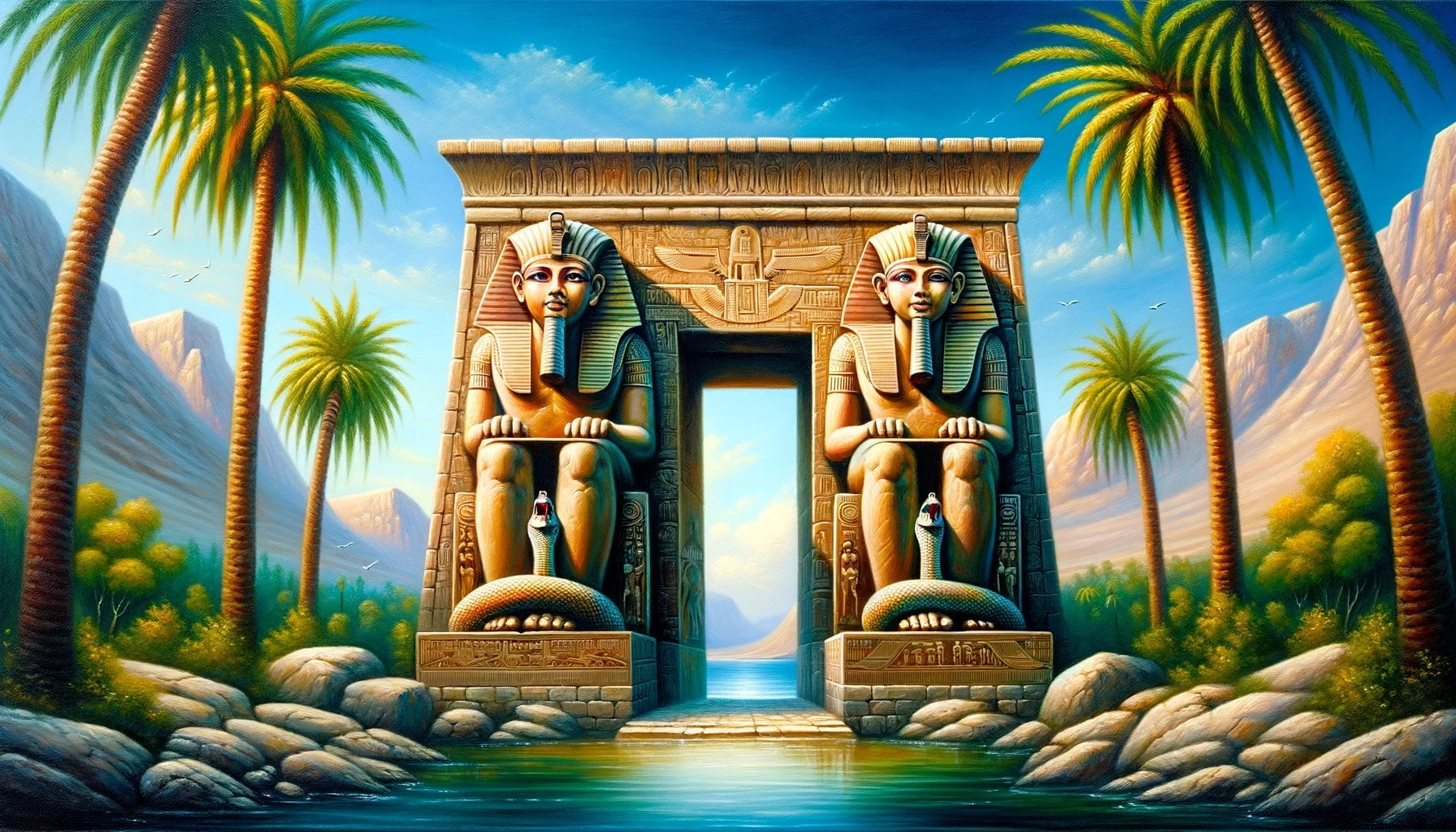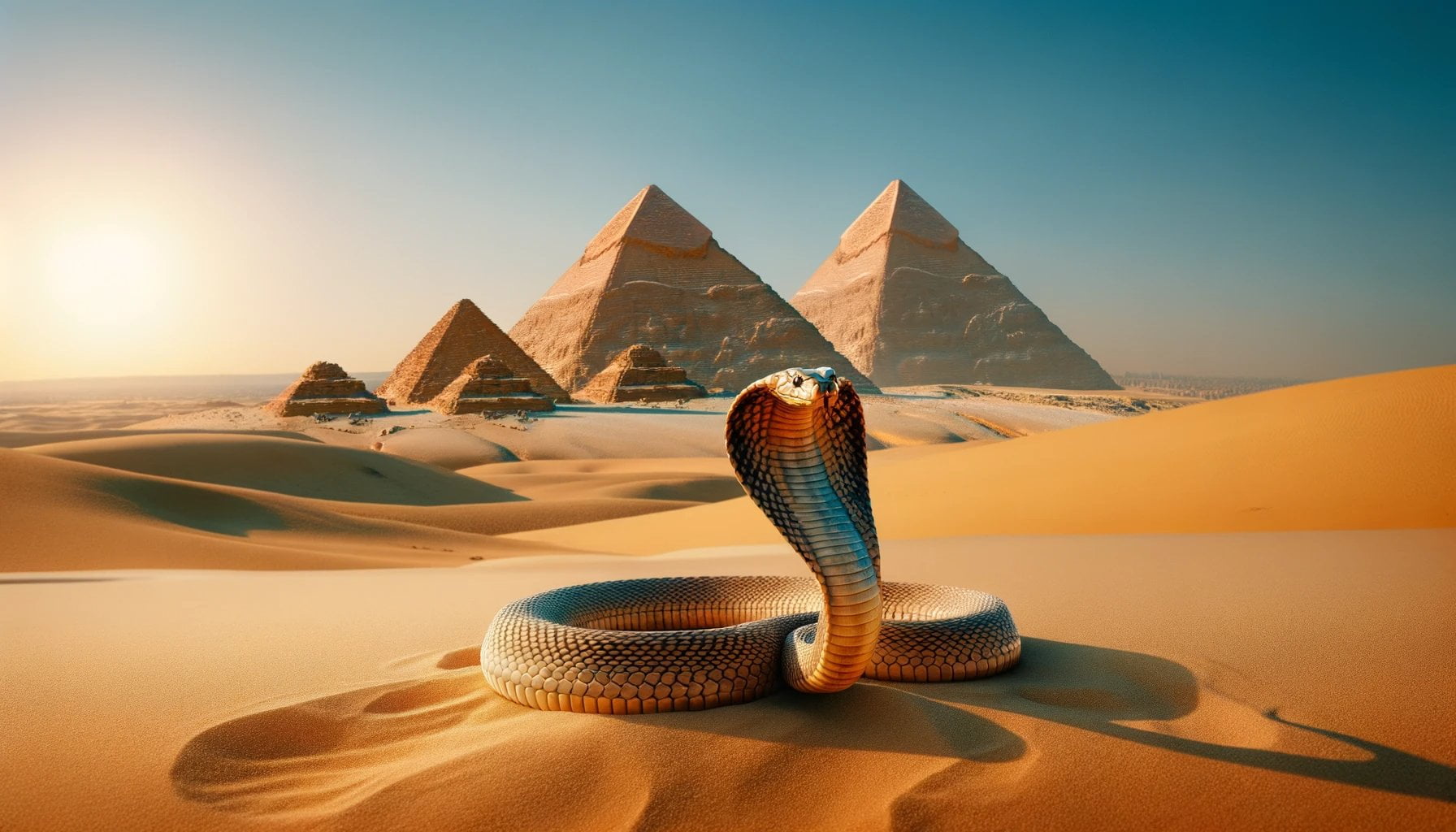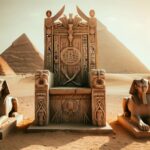Unveiling the captivating world of the snakes in ancient Egypt, this article titled “Revealing the Mystical Allure: Snakes in Ancient Egypt” delves into the symbolic representations, religious beliefs, and mystical allure of these revered creatures. With a deep passion for ancient history and expertise in reptile biology, the author, an experienced herpetologist, combines extensive fieldwork and knowledge of ancient Egyptian texts to shed light on the mesmerizing era that celebrated and revered snakes.

Key Takeaways:
- Snakes held significant roles in ancient Egyptian culture, representing both positive and negative connotations.
- The uraeus cobra symbolized royalty and was associated with the protection and divine authority of pharaohs.
- Apophis, the archenemy of the sun god Re, embodied chaos and represented destructive forces.
- The shedding of skin by snakes symbolized the concept of rebirth and the eternal cycle of life and death.
- Ancient Egyptian papyri provide evidence of the Egyptians’ knowledge and understanding of snakes, including venomous species and their associations with specific deities.
- Snakes in ancient Egypt offered insight into the beliefs and close connection with the natural world and the divine.
Snakes in Ancient Egypt: Symbolism and Mythology
When exploring the rich history of ancient Egypt, it is impossible to ignore the fascinating role that snakes played in their culture. These creatures held both positive and negative connotations, symbolizing various aspects of Egyptian mythology and belief systems.
One of the most prominent snake figures in ancient Egypt was the uraeus cobra. This particular snake was considered the protector of the king, representing royalty and divine authority. It adorned the crowns of pharaohs, emphasizing their position as rulers and offering them protection. The uraeus cobra was also associated with the goddess Wadjet, who safeguarded Lower Egypt. Ancient Egyptians believed that the fertility and productivity of the land depended on her, and she had the power to wield fire for protection.
In contrast to the uraeus cobra’s positive symbolism, there was another significant snake figure known as Apophis or Apep. This snake represented chaos and destruction, appearing as the archenemy of Re, the sun god. According to ancient Egyptian beliefs, Apophis attempted to devour the sun during its nightly journey through the underworld. It was the duty of Re to defeat Apophis and maintain order, protecting the world from chaos.
The ability of snakes to shed their skins also held profound symbolism in ancient Egyptian culture. This act of shedding represented a cyclical process of renewal and regeneration, linking it to the concept of the afterlife and the eternal cycle of life and death. This connection between snakes and rebirth was further reflected in Egyptian mythology, where several snake deities were associated with this concept.
Ancient Egyptian papyri are a valuable source of evidence showcasing the Egyptians’ knowledge and understanding of snakes. A papyrus housed in the Brooklyn Museum provides descriptions of various snake species, including venomous ones, illustrating the Egyptians’ intimate familiarity with these creatures. Furthermore, the papyri associate specific snakes with different gods and goddesses, highlighting their significance in Egyptian mythology.
In the grand tapestry of ancient Egyptian culture, snakes held diverse meanings, representing protection, royalty, chaos, and rebirth. Through their symbolism and mythology, snakes offer a glimpse into the Egyptian beliefs, as well as their profound connection with the natural world and the divine.
Sources:
- Swan.ac.uk. “Snakes – Y Ganolfan Eifftaidd/Egypt Centre.” Link
- My Animals. “Snakes in Ancient Cultures.” Link
Note: The information provided in this article is based on the content from the above sources.
Are you fascinated by the supreme god of ancient Egypt? Discover more about the divine being worshipped by the ancient Egyptians by clicking here.
Uncover the secrets of magic in ancient Egypt and explore the mystical practices that were held in high regard by the ancient Egyptians. Click here to transport yourself to the world of ancient Egyptian enchantment.
Interested in the intricate laws that governed ancient Egypt? Delve into the 10 laws of ancient Egypt and gain insights into their legal system by clicking here.
Unveil the bird venerated in ancient Egypt and the symbolism it held within their culture. Discover more about this revered creature by clicking here.
Explore the fascinating crocodile god of ancient Egypt and the significance it held in their belief system. Click here to delve deeper into the worship of this ancient deity.
Did you know that even toothpaste had a place in ancient Egypt? Learn about the toothpaste practices of the ancient Egyptians and their quest for oral hygiene by clicking here.
Unearth the dark side of ancient Egypt and uncover the bad things that occurred during this remarkable civilization. Click here to uncover the shadows that lurked beneath the glorious facade.
Discover the significance of black cats in ancient Egypt and their perceived powers. Dive into the mystical world of these feline companions by clicking here.
Step into the lives of the powerful and influential ancient queens of Egypt. Click here to unravel the stories of these remarkable women who left a lasting legacy.
Unlock the mysteries of ancient Egypt and embark on a journey into the enigmatic realm of pharaohs and pyramids. Click here to satisfy your curiosity and quench your thirst for knowledge.
Religious Beliefs Associated with Snakes in Ancient Egypt
The snakes of ancient Egypt held a profound significance in the religious beliefs and mythology of this captivating era. Revered and feared, these creatures played a complex role in Egyptian culture, symbolizing various aspects of their belief systems and the mystical allure of the ancient world. Let’s delve into the religious beliefs associated with snakes in ancient Egypt and unravel their fascinating significance.
The Cobra: Symbol of Divine Authority
One of the most prominent and celebrated symbols in ancient Egyptian culture was the cobra, specifically the uraeus cobra. This serpent was strongly associated with the sun god Ra and other deities, representing their divine authority and protection. The cobra was also linked to the goddess Wadjet, who safeguarded Lower Egypt and possessed the power to wield fire for protection. As a protector of the king, the uraeus cobra held a position of great significance, embodying royalty and divine power.
Apophis: The Archenemy of the Sun God
Within the pantheon of ancient Egyptian mythology, the snake-figure known as Apophis or Apep embodied chaos and destruction. Considered the archenemy of the sun god Re, it was believed that Apophis sought to interrupt the daily journey of the sun across the sky. Ancient Egyptians regarded the successful defense against Apophis as crucial in safeguarding order and ensuring harmony in their world.
Symbolic Representations of Strength, Renewal, and Knowledge
Snakes were seen as potent symbols of strength, renewal, and knowledge in ancient Egypt. The ability of snakes to shed their skins represented a cyclical process of renewal and regeneration, which was intimately connected to the concept of the afterlife and the eternal cycle of life and death. This shedding of skin also served as a powerful metaphor for personal growth, transformation, and the pursuit of wisdom.
Protectors of the King and Guardians of the Underworld
In addition to their association with deities and divine authority, snakes were considered protectors of the king and demons of the underworld. They were believed to possess the power to ward off evil spirits and safeguard the deceased in their journey to the afterlife. The protective nature of snakes made them integral to the religious rituals and beliefs of ancient Egyptians, symbolizing their quest for spiritual protection and guidance.
With their multifaceted symbolism and spiritual significance, snakes played a vital role in the religious beliefs of ancient Egypt. From the uraeus cobra representing divine authority to the archenemy Apophis symbolizing chaos, these revered creatures left an indelible mark on the culture and spirituality of this mesmerizing era.
Key Takeaways:
- The uraeus cobra symbolized divine authority and protection, associated with the sun god Ra and the goddess Wadjet.
- Apophis, a snake-figure, represented chaos and was the archenemy of the sun god Re.
- Snakes represented strength, renewal, and knowledge, with their ability to shed their skins symbolizing regeneration and personal growth.
- Snakes were protectors of the king and guardians of the underworld, playing a crucial role in Egyptian religious rituals.
- Ancient Egyptians believed in the spiritual significance of snakes, seeking their protection and guidance.
Sources:
– Slithering Through Egypt, Emory University [^1^]
– Fun Info about Snakes in Egyptian Mythology, learningmole.com [^2^]
[^1^]: Slithering Through Egypt, Emory University
[^2^]: Fun Info about Snakes in Egyptian Mythology, learningmole.com
Mystical Allure and Magical Properties of Snakes in Ancient Egypt
Snakes hold a mesmerizing place in the ancient Egyptian culture, with their mystical allure and magical properties capturing the imagination of both ancient Egyptians and modern-day enthusiasts. Let’s dive into the captivating world of these revered creatures and explore their significance in the context of ancient Egypt.
Snake Gods and Goddesses:
Snake gods and goddesses were worshipped in various cultures throughout history, and ancient Egypt was no exception. One prominent snake goddess in Egyptian mythology is Renenutet. Interestingly, Renenutet is depicted differently in various images, sometimes as a cobra or as a serpent with a human head. Another significant deity is Nehebkau, the primeval snake god believed to be the son of Renenutet. These snake gods and goddesses held immense importance in religious practices and belief systems of ancient Egypt.
Apep – The Lord of Chaos and God of Death:
Among the snake gods in ancient Egyptian mythology, Apep stood out as the “Lord of Chaos” and the “god of death.” Apep was considered the archenemy of the sun god Re, representing chaos and destruction. The ancient Egyptians revered and feared Apep’s power, believing that maintaining order in the world depended on safeguarding against his malevolence.
Meretseger – The Snake Goddess of Mercy and Punishment:
Meretseger, another snake goddess of ancient Egypt, held a dual role associated with both mercy and punishment. She was believed to protect and heal those who sought her favor, while also being capable of delivering divine judgement to wrongdoers. This duality of power is a testament to the complex and profound symbolism attributed to snakes in the ancient Egyptian culture.
Snake Worship in Ancient Egypt and Beyond:
The ancient Egyptians were not alone in their reverence for snakes. Snakes have been worshipped and held sacred in various cultures around the world for centuries. Greek mythology, for instance, included Asclepius, a snake god renowned for his medical prowess. These examples highlight the cross-cultural importance of snakes and their association with mysticism and spiritual beliefs.
Symbolic and Metaphorical Significance:
Snakes have long been valued as symbols of immortality and fertility. The ability to shed their skin represented a cyclical process of renewal and regeneration, often linked to the concept of the afterlife and the eternal cycle of life and death. In ancient Egyptian culture, snakes symbolized protection, royalty, chaos, and rebirth. They were seen as potent symbols of strength, renewal, and knowledge, reflecting the Egyptians’ deep understanding and appreciation of the natural world.
Key Takeaways:
- Snake gods and goddesses, such as Renenutet and Nehebkau, held significant roles in ancient Egyptian mythology.
- Apep, the snake god known as the “Lord of Chaos” and the “god of death,” was the archenemy of the sun god Re.
- Meretseger, associated with both mercy and punishment, was another important snake goddess in ancient Egypt.
- Snakes have been worshipped and considered sacred in various cultures across the globe.
- In ancient Egyptian culture, snakes symbolized immortality, fertility, protection, royalty, chaos, and rebirth.
Sources:
Role of Snakes in Ancient Egyptian Society and Rituals
Throughout ancient Egyptian history, snakes played a significant role in society and rituals, symbolizing various aspects of mythology and belief systems. Let’s dive into the captivating world of these revered creatures and explore their mystical allure in this mesmerizing era.
Snakes as Symbols of Rejuvenation and Eternity
In ancient Egypt, snakes were associated with eternity and the renewal of life. They symbolized rejuvenation, life energy, and resurrection. The ouroboros, a snake swallowing its tail, served as a powerful representation of rejuvenation and eternity.
The Dual Nature of Snakes in Ancient Egyptian Religion
Snakes held both positive and negative connotations in the ancient Egyptian religion. On one hand, they represented wisdom, power, and life energy. On the other hand, they were also associated with death, darkness, evil, and corruption.
The Fascination with Shedding Process
Ancient Egyptians had a profound fascination with a snake’s skin shedding process, which symbolized the rebirth of life. This cyclical process of renewal was linked to the concept of the afterlife and the eternal cycle of life and death.
Snake Worship and Hieroglyphs
Snake worship was a common practice in ancient Egyptian culture, depicting devotion to serpent deities. In ancient Egyptian tombs, snake hieroglyphs were often shown cut by knives to prevent harm to the deceased.
Iconic Snakes in Ancient Egypt
One of the most feared snakes in ancient Egypt was the horned viper, also known as the sand viper. These venomous reptiles were found in various landscapes, including the desert, walls, the Nile, countryside, houses, and cattle stables.
Key Takeaways:
- Snakes in ancient Egyptian society symbolized rejuvenation, eternity, life energy, resurrection, wisdom, and power.
- The ouroboros, a snake swallowing its tail, represented rejuvenation and eternity.
- Snakes were both good and bad in ancient Egyptian religion, associated with death, darkness, evil, and corruption.
- The shedding process of snakes fascinated ancient Egyptians, symbolizing the rebirth of life.
- Snake worship was a common practice, and snake hieroglyphs were depicted in tombs, often cut by knives to avoid harm to the deceased.
- The horned viper or sand viper was one of the most feared snakes in ancient Egypt, found in various landscapes.
Sources:
– Egypt Magic – Snakes in ancient Egypt
– THE SERPENT IN EGYPT AND IN THE BIBLE: EVIL, POWER AND HEALING

FAQ
Q1: What role did snakes play in ancient Egyptian culture?
A1: Snakes played significant roles in ancient Egyptian culture, representing both positive and negative connotations. They were associated with various deities and mythological figures, symbolizing protection, royalty, chaos, and rebirth.
Q2: How were snakes depicted in ancient Egyptian art?
A2: Snakes were often depicted in ancient Egyptian art, particularly the uraeus cobra. The uraeus cobra symbolized royalty and was depicted on the pharaohs’ crowns. Additionally, snakes were depicted shedding their skins, symbolizing the concept of rebirth and renewal.
Q3: How were snakes viewed in ancient Egyptian mythology?
A3: In ancient Egyptian mythology, certain snakes were revered and worshipped while others were seen as embodiments of chaos and destruction. The uraeus cobra, associated with the sun god Re, represented protection and divine authority, while Apophis or Apep represented destructive forces and the battle against chaos.
Q4: Were snakes worshipped in ancient Egypt?
A4: Yes, snakes were worshipped in ancient Egypt. They were considered protectors of the king and had associations with various deities. The shedding of snake skins and their representation in Egyptian mythology highlighted their significance in religious practices.
Q5: How did the ancient Egyptians view snake bites?
A5: Snake bites were treated with a mix of fear and reverence. While snakes were viewed as a threat due to the harm they could cause, they were also respected for their role in controlling pests such as mice and rats that fed on grain. Snake bites were seen as a potential danger to humans and animals in ancient Egypt.









